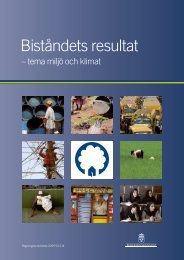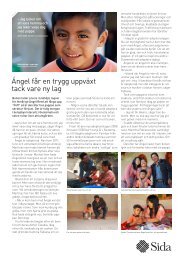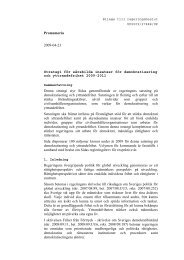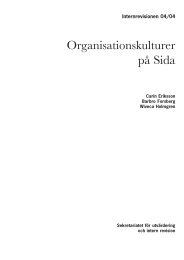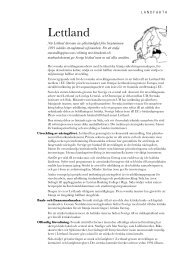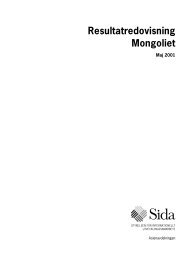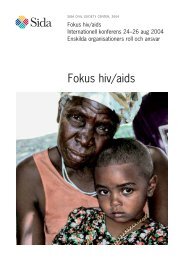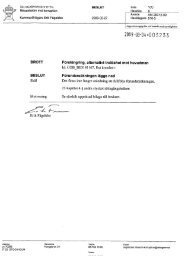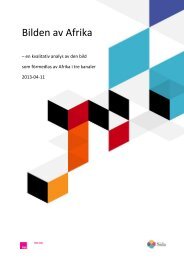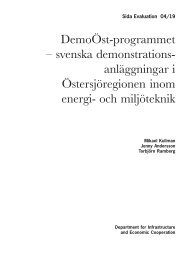Mobilisation of the Poor – a means to Poverty Reduction? - Sida
Mobilisation of the Poor – a means to Poverty Reduction? - Sida
Mobilisation of the Poor – a means to Poverty Reduction? - Sida
Create successful ePaper yourself
Turn your PDF publications into a flip-book with our unique Google optimized e-Paper software.
achievements <strong>of</strong> certain obviously successful cases while neglecting <strong>the</strong> failures, which are just as<br />
common (e.g. Dainis and Karunaratna 2001, Pathirana and Ekanayake 1999). This, in turn, has<br />
made it difficult <strong>to</strong> arrive at a realistic assessment <strong>of</strong> <strong>the</strong> strengths and weaknesses <strong>of</strong> <strong>the</strong> approach<br />
being pursued.<br />
10<br />
CAP<br />
Successes<br />
The field survey covered 11 Prajashakti Organisations out <strong>of</strong> a <strong>to</strong>tal <strong>of</strong> 53 registered with <strong>the</strong><br />
Prajashakti Maha Sangamaya (PSMS) national federation as <strong>of</strong> May 2001. The study units were<br />
selected on <strong>the</strong> basis <strong>of</strong> geographical, socio-economic and programme characteristics. Details <strong>of</strong> <strong>the</strong><br />
selected study units are given in Table 1 (see Statistical Tables in Annex 1).<br />
In each study area <strong>the</strong> following procedures were carried out:<br />
1. From each Prajashakti Organisation (PO) selected basic information about membership, funds<br />
and activities was collected from <strong>the</strong> principal <strong>of</strong>fice bearers.<br />
2. Two villages (one where CAP is active and one where it is less active) were selected from each<br />
PO for detailed field investigations.<br />
3. Case his<strong>to</strong>ries were recorded <strong>of</strong> CAP and related group processes in each <strong>of</strong> <strong>the</strong> study villages.<br />
4. A sample survey covering four types <strong>of</strong> households (those currently active in CAP, those<br />
currently enrolled but not active in CAP, those that dropped out <strong>of</strong> CAP, and those who are<br />
poor but have never been involved in CAP). The survey covered a <strong>to</strong>tal <strong>of</strong> 342 households in<br />
five provinces (see Table 2). The survey was carried out by a team <strong>of</strong> 13 field investiga<strong>to</strong>rs (five<br />
men and eight women, all sociology graduates) under <strong>the</strong> supervision <strong>of</strong> <strong>the</strong> members <strong>of</strong> <strong>the</strong><br />
evaluation team.<br />
Selection <strong>of</strong> <strong>the</strong> sample<br />
CAP<br />
Failures<br />
The 11 Prajashakti Organisations covered by <strong>the</strong> study were chosen from a list <strong>of</strong> 53 POs taking<br />
in<strong>to</strong> consideration geographical location, duration <strong>of</strong> <strong>the</strong> programme in each area, level <strong>of</strong> activity<br />
<strong>of</strong> <strong>the</strong> organisation as assessed by <strong>the</strong> national federation <strong>of</strong> POs and reported level <strong>of</strong><br />
organisational maturity. In selecting <strong>the</strong> study POs maximum care was taken <strong>to</strong> represent all<br />
possible variation.<br />
From each PO chosen for <strong>the</strong> study a list <strong>of</strong> all villages covered by <strong>the</strong> PO was obtained and out <strong>of</strong><br />
<strong>the</strong>se two villages were chosen. In selecting <strong>the</strong> villages <strong>the</strong>ir distance from <strong>the</strong> PO <strong>of</strong>fice, reported<br />
level <strong>of</strong> activity, duration <strong>of</strong> <strong>the</strong> programme, socio-economic characteristics and presence or<br />
absence <strong>of</strong> o<strong>the</strong>r relevant development programmes were considered.<br />
From each study village about 15 households were chosen for a household survey. Out <strong>of</strong> <strong>the</strong> 15<br />
households five were chosen from among households currently active in CAP, and ano<strong>the</strong>r five<br />
from among households that are currently served by <strong>the</strong> Samurdhi Programme or a nongovernment<br />
programme catering <strong>to</strong> low-income households such as Sarvodaya or SANASA. The<br />
MOBILISATION OF THE POOR <strong>–</strong> A MEANS TO POVERTY REDUCTION <strong>–</strong> <strong>Sida</strong> EVALUATION 02/08<br />
Samurdhi and<br />
o<strong>the</strong>r<br />
programmes




